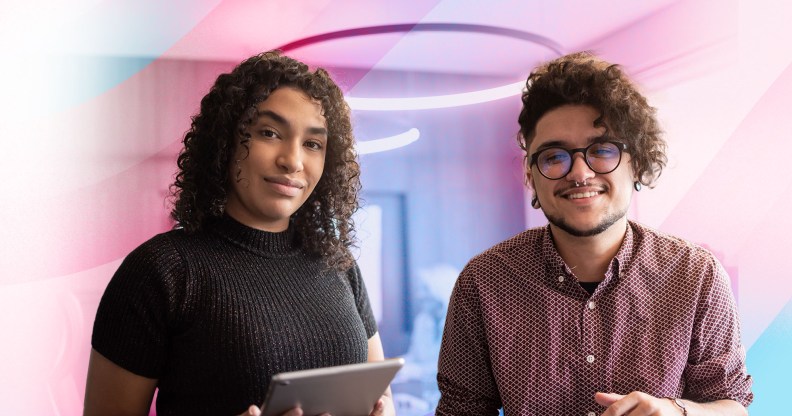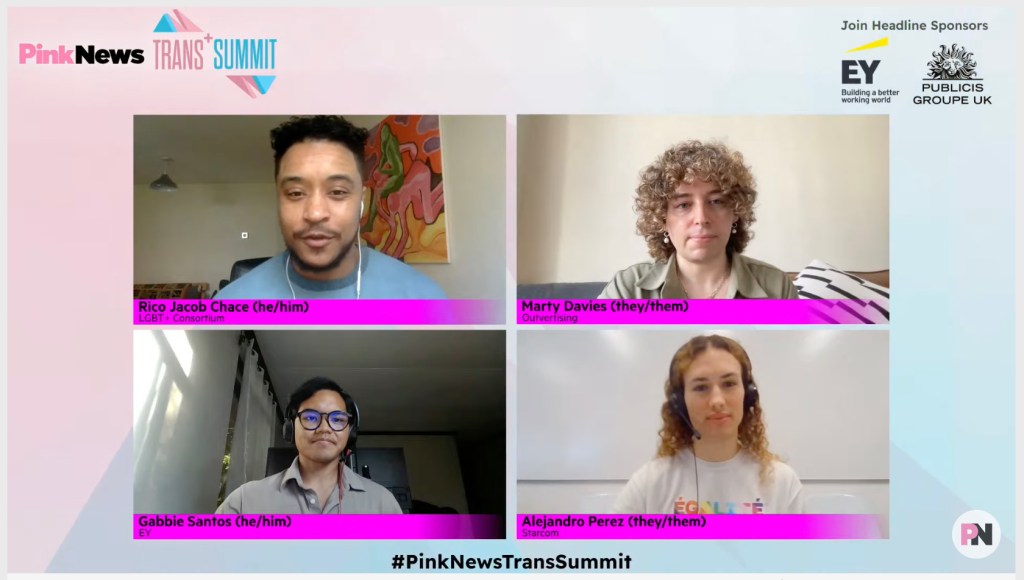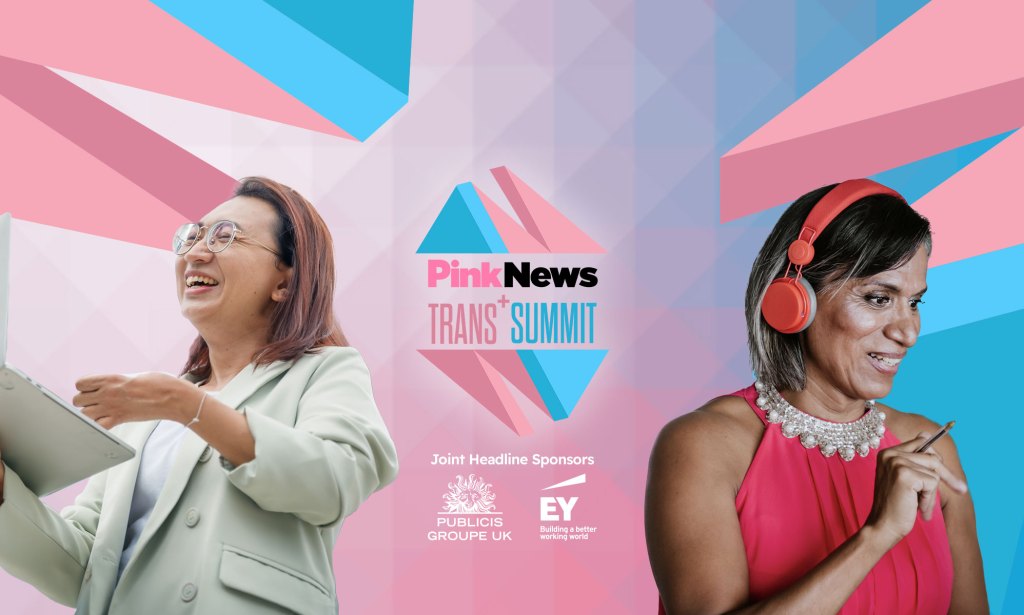Experts share advice for better trans and non-binary inclusion at work: ‘A lot of us are hidden’

The PinkNews Trans+ Summit saw industry experts come together to share vital insights for businesses. (Getty Images/PinkNews)
For businesses to be truly inclusive for trans, non-binary and gender-diverse employees, they must understand what the foundations of inclusion at work really look like.
PinkNews assembled a diverse group of trans rights advocates, professionals and business leaders for the virtual PinkNews Trans+ Summit last Thursday (11 May). The first session of the day was dedicated to gaining a deeper understanding of the fundamentals of inclusion for trans and gender-diverse communities.
Hosting the session was Rico Jacob Chace, board member and trustee at the LGBT+ Consortium. Joining him was Marty Davies, joint CEO of Outvertising, Gabbie Santos, senior consultant at EY, and Alejandro Perez, a senior account executive at Starcom.
Together, the panel discussed what inclusion looks like to them, the importance of allyship at work, and offered advice for business leaders on how to start their inclusion journey.
Chace kicked off the 45-minute long session by stating that many outside the LGBTQ+ community think that trans issues at work is simply a matter of pronouns and bathrooms. Although those issues contribute to inclusion, the trans and non-binary experience involves a broader range of factors.
“It’s about feeling comfortable and feeling safe to express one’s identity without the burden of expectations and stereotypes.”
Gabbie Santos, senior consultant at EY
Using his own journey as a framework, Santos boiled down inclusion to one thing: a safe environment.
“It’s about feeling comfortable and feeling safe to express one’s identity without the burden of expectations and stereotypes,” he said.
“I say journey because we all are on a certain journey of self-discovery, figuring out how we like to identify, and then how we like to present ourselves to the world as well,” he added.
Through their own experience, Perez appreciated policies that normalised the transitioning process.
“I’ve appreciated for a company to have resources available, either from a mental health perspective or other kinds of support resources for all employees, including employees who transition at work,” they said.
“In my own experience, what I found very, very helpful was having private medical insurance that would help me access treatments.”
Davies agreed that supporting a name change through company systems is a small way to acknowledge trans and non-binary employees. Yet, due to antiquated policies and a lack of understanding from employers, it can be quite difficult to change an employee’s name.
“Changing your name can be difficult because the name change policies tend to be written around someone that is maybe changing their name due to a marriage,” they admit.
“So there’s less sensitivity about people knowing or being exposed to your former name because it’s not as triggering or it can out you to people that you haven’t met within the business before.”

Another important fundamental aspect of inclusion is allyship. There are many ways businesses, leaders and colleagues can be proper allies, and for Chace, one of the key ones is helping to generate a safe space.
“We really need to give people the forums to create their own safe spaces to share stories and work out precisely what the organisation needs to do in order to be more trans-inclusive,” he said.
Perez agreed, declaring: “The best form of allyship to find is finding community and finding those spaces where I can connect with people and have support outside of my day-to-day role.”
“We need that strong allyship to drive the change because they can take on the burden that isn’t personally affecting them in the same way.”
Marty Davies, joint CEO at Outvertising
The panel all agreed that oftentimes, the onus of responsibility towards total inclusion falls onto the trans community – and that proper allyship involves taking on some of that responsibility.
As Davies put it: “A lot of us are hidden as well because we’re not open at work because of lack of inclusion policies.
“So we need that strong allyship to drive the change because they can take on the burden that isn’t personally affecting them in the same way.”
As well as being a senior consultant at EY, Santos is also the trans and non-binary community lead at the firm’s LGBTQ+ network.
“It’s a very rewarding role, but at the end of the day, that’s not my 100 per cent time commitment,” he admitted.
“So strong allyship definitely is when they’re willing to step in and drive some of those initiatives.”

Chace brought up the issue of visibility versus accountability, noting that not every trans and non-binary employee necessarily wants to be the centre point of conversation.
“There’s a pretty significant difference between sort of tokenism and pink-washing and actually creating safe places internally within the organisation,” he declared. “And employees do know the difference, we do definitely know the difference.”
“Some trans and non-binary employees don’t actually want to be in the front and in the public eye. This personal part of us is one of the many multifaceted parts of our identity.”
“There will always be opportunities to find that support externally where you can where you can count on experts to support or start your allyship journey.”
Alejandro Perez, senior account executive at Starcom
Wrapping up the discussion, the panellists each shared their own tips for how businesses can begin their inclusion journey. For Perez, being able to have someone to talk to for support is a good starting point – and if needed – bringing in outside consultancy or experts to assist.
“I would say that it would be ideal if everyone could have support from within their organisation and be able to reach out to someone whether that is a diversity and inclusion team or someone within HR that specialises in D&I.”
“I’m conscious that not everyone might be able to find that support within their organisation,” they continued. “So what I would say is, there will always be opportunities to find that support externally where you can where you can count on experts to support or start your allyship journey.”
For Davies, the easiest way to kick off an inclusive environment is a really simple one, but one that doesn’t happen often enough.
“Whenever you’re in a meeting, and you’re finding yourself introducing yourself, introduce your pronouns,” they say. “You’ll make any trans, non-binary, gender-diverse or intersex people in that room feel instantly more welcome and comfortable sharing theirs – and you’re creating that safe environment we’ve been talking about.”
For Gabbie Santos, asking colleagues about their experience “is a really important part of one’s allyship journey” – but he stressed that people should “always check in first” to gauge each individual’s “comfort levels”.
“I think a lot of people tend to tiptoe, not wanting to say the wrong thing. We can sense if your question is genuine and respectful,” they concluded.

